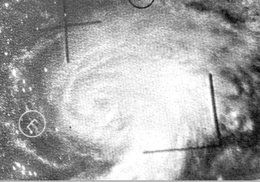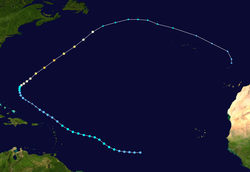Hurricane Arlene (1963)
Hurricane Arlene was the first tropical cyclone of the 1963 Atlantic hurricane season and one of the wettest storms ever recorded in Bermuda. Originating from a tropical depression on July 31, Arlene quickly intensified into a Category 2 hurricane on August 2. After attaining this intensity, the storm quickly weakened and turned west. By August 4, Arlene had degenerated into a tropical depression. The storm failed to re-organize until August 7, by which time it restrengthened into a tropical storm. The following day, Arlene re-attained hurricane-status before passing directly over Bermuda. Several hours after passing the island, it reached its peak intensity with winds of 115 mph (160 km/) and a barometric pressure of 969 mbar (hPa; 28.61 inHg). By August 11, Arlene transitioned into an extratropical cyclone before being absorbed by another cyclone later that day.
| Category 3 major hurricane (SSHWS/NWS) | |
 Satellite image of Arlene as a minimal hurricane on August 10 | |
| Formed | July 31, 1963 |
|---|---|
| Dissipated | August 11, 1963 |
| Highest winds | 1-minute sustained: 115 mph (185 km/h) |
| Lowest pressure | 969 mbar (hPa); 28.61 inHg |
| Fatalities | None reported |
| Damage | $300,000 (1963 USD) |
| Areas affected | Lesser Antilles, Bermuda |
| Part of the 1963 Atlantic hurricane season | |
Along its track, several hurricane warnings and watches were issued for the Leeward Islands; however, no damage was reported on any of the islands. The storm has its greatest impact in Bermuda where high winds and near-record rainfall downed trees, power lines and caused flooding. Damages across the island amounted to $300,000 (1963 USD; $2.1 million 2009 USD).
Meteorological history

Hurricane Arlene was first identified as a tropical depression on July 31 between the Lesser Antilles and the Cape Verde Islands by the TIROS VI satellite. The large cyclone, estimated at five degrees in diameter,[1] steadily tracked westward and eventually northwestward and intensified into a tropical storm on August 2.[2] Later that day, a Navy reconnaissance aircraft reached the storm and found a clear eye and a barometric pressure of 987 mbar (hPa; 29.15 inHg), resulting in Arlene being classified a hurricane.[3] This meant that the storm had rapidly intensified from a tropical depression to a hurricane within the span of 18 hours. The intensification continued for another 6 hours, at which time the storm attained its initial peak strength with winds of 100 mph (155 km/h), classifying Arlene as a Category 2 hurricane.[2]
Early on August 3, Arlene began to weaken as it turned towards the west once more.[1] The storm continued to slowly weaken before rapidly degenerating into a tropical depression on August 4.[2] The quick decrease in intensity was the result of a sudden increase in vertical wind shear near the core of the cyclone.[3] Later that day, the system passed near the northern Leeward Islands;[2] however, the depression was poorly organized.[1] The former hurricane steadily tracked northwestward and began to regenerate on August 7.[3]
As the storm began to reorganize, the forward motion had become virtually stationary but later began to increase as Arlene turned northeastward, beginning recurvature into the main belt of the Westerlies.[3] Ships in the vicinity of the depression reported that it had regained gale-force winds on August 8,[1][2] resulting in advisories on Arlene being re-initiated around that time.[3] Later that day, a Navy reconnaissance plane found hurricane-force winds around the center of the storm, resulting in Arlene being upgraded to a minimal hurricane a second time.[1]
During the day on August 9, Arlene passed directly over Bermuda with winds of 85 mph (140 km/h).[2][3] The storm continued to intensify after passing the island, with reconnaissance recorded a minimum pressure of 969 mbar (hPa; 28.61 inHg)[3] and maximum winds reached 105 mph (160 km/h).[2] The hurricane began to weaken hours later,[1] with winds decreasing below 100 mph (155 km/h) by the afternoon of August 10. Shortly after, Arlene transitioned into an extratropical cyclone, while maintaining hurricane-force winds, over the north Atlantic.[2] The remnants were absorbed by a larger cyclone near Newfoundland on August 11.[1]
Preparations and impact
| Precipitation | Storm | Location | Ref. | ||
|---|---|---|---|---|---|
| Rank | mm | in | |||
| 1 | 186.7 | 7.35 | October 1939 Hurricane | [4] | |
| 2 | 172.0 | 6.77 | Nicole 2016 | [5] | |
| 3 | 153.7 | 6.05 | Arlene 1963 | [6] | |
| 4 | 151.4 | 5.96 | Cristobal 2002 | ||
| 5 | 148.0 | 5.83 | Nicole 2004 | ||
| 6 | 134.1 | 5.28 | T.D. #23A 1967 | [6] | |
| 7 | 126.2 | 4.97 | Franklin 2005 | ||
| 8 | 125.0 | 4.92 | Emily 1981 | [6] | |
| 9 | 124.0 | 4.88 | Harvey 2005 | ||
| 10 | 123.2 | 4.85 | September 1948 hurricane | [4] | |
On August 3, the National Weather Service in San Juan, Puerto Rico issued hurricane warnings for the northern Leeward Islands and a hurricane watch for the Virgin Islands. Later that day, the watch was expanded to include Puerto Rico.[7] By August 4, the hurricane warnings were lowered to gale warnings and the watch was discontinued as Arlene weakened to a tropical storm. Later that day, all warnings were canceled since the storm had further weakened to a tropical depression.[8] On August 8, after Arlene regenerated, residents in Bermuda were advised to not venture offshore on any vessel and rush all hurricane preparations to completion.[9]
In Bermuda, Arlene produced winds up to 85 mph (140 km/h) and a pressure of 974.5 mbar (hPa; 28.78 inHg) was recorded during its passage.[3] A maximum gust of 98 mph (158 km/h) was recorded at Kindley Air Force Base.[10] Tree limbs and power lines were downed across the island, a few small boats sank in rough seas and flooding was reported in some areas.[11] The hurricane produced one of the highest tropical cyclone-related rainfall totals on the island, peaking at 6.05 in (154 mm),[6] in addition to an estimated 4 ft (1.2 m) storm surge.[12] In all, damage in Bermuda amounted to $300,000 (1963 USD; $2.1 million 2009 USD).[1]
References
- Gordon E. Dunn (1964). "The Hurricane Season of 1963" (PDF). United States Weather Bureau Office in Miami, Florida. Retrieved September 6, 2009.
- Hurricane Specialists Division (2009). "Easy to Read HURDAT 2008". National Hurricane Center. Retrieved September 6, 2009.
- Staff Writer (1964). "Hurricane Arlene Preliminary Report Page Three". United States Weather Bureau Office. Retrieved September 6, 2009.
- Terry Tucker (1966). Beware the Hurricane! The Story of the Cyclonic Tropical Storms That Have Struck Bermuda and the Islanders' Folk-lore Regarding Them (1 ed.). The Hamilton Press. p. 206.
- "BWS Daily Climatology Written Summary". Bermuda Weather Service. October 26, 2016. Retrieved October 26, 2016.
- Roth, David M. (October 18, 2017). "Tropical Cyclone Point Maxima". Tropical Cyclone Rainfall Data. United States Weather Prediction Center. Retrieved November 26, 2017.
- Davis and Zimmer (1964). "Hurricane Arlene Preliminary Report Page Four". United States Weather Bureau Office. Retrieved September 6, 2009.
- Hoose, Higgs and Davis (1964). "Hurricane Arlene Preliminary Report Page Five". United States Weather Bureau Office. Retrieved September 6, 2009.
- Dunn, Sugg and Moore (1964). "Hurricane Arlene Preliminary Report Page Twelve". United States Weather Bureau Office. Retrieved September 6, 2009.
- Moore and Clark (1964). "Hurricane Arlene Preliminary Report Page Thirteen". United States Weather Bureau Office. Retrieved September 6, 2009.
- United Press International (August 10, 1963). "Arlene moves out to sea after hitting Bermuda". The Bend Bulletin. Retrieved September 6, 2009.
- Dunn, Gordon E.; Miller, Banner I. (1964). Atlantic Hurricanes. Baton Rouge: Louisiana State University Press. p. 352.
